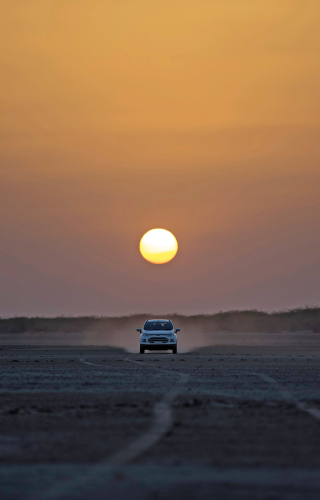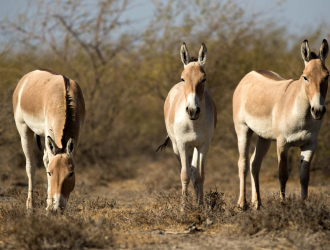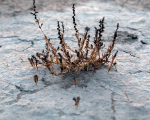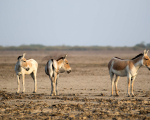The pungent smell of salt in the air is the first thing that welcomed me as I reached the Little Rann of Kutch region after crossing Viramgam, the nearest railhead and entry point to the Rann. Thick, thorny bushes bordered both sides of the elevated road, while the landscape changed to flat parched earth, extending as far as the eye could see. There was very little vegetation cover and the vast emptiness looked inhospitable.
Though it is contiguous to the Great Rann of Kutch, the Little Rann of Kutch is not to be confused with the much larger Great Rann. The Little Rann sustains rich biodiversity, many unique to the region. A native of this arid ecosystem is the Indian wild ass which roams within the protected Indian Wild Ass Sanctuary (IWAS), which was set up in 1973, covering 4,954 square kilometres. In Kutchi language, the Indian wild ass is called ghorkhar, and its scientific name is Equus hemionus khur. IWAS is the only region in India where they still live in the wild, because unlike donkeys and its relative the horse, the wild ass was never successfully domesticated. Feral populations also survive in similar desert ecosystems in Pakistan and Iran and in the vast steppes of the Central Asian countries such as parts of China and Mongolia.
The saline plains of the Little Rann are usually bone dry throughout the year, but during monsoons they flood, creating marshlands with patches of elevated islands, called bets. These bets support grasslands where the Indian wild ass graze with chinkaras and nilgais. Scanning the shimmering horizon, I notice, far away, a cluster of slow-moving dots. This distant glimpse is my first sighting of the elusive wild ass as they nonchalantly graze in the scorching afternoon heat. A tough and hardy animal, the Indian wild ass can survive in extreme temperatures with little water because it is a subspecies of the Asiatic wild ass which once roamed in the deserts of Saudi Arabia, Iraq, Jordan, Israel, Syria and Afghanistan. However, its population has dwindled, and one subspecies, the Syrian wild ass, has been driven to extinction. The Indian wild ass is one of the four surviving subspecies of the Asiatic Wild Ass, the others being the Persian onager, the Turkmenian kulan and the Mongolian wild ass. Their coat is usually sandy, and provide excellent camouflage.
Even if they are spotted, it is very difficult to get close to them because they are notoriously shy animals. If threatened, the wild ass can be deceptively quick to bolt. With top speed reaching up to eighty kilometres per hour, they can easily outrun a fast jeep. This makes the wild ass difficult to track. This may have discouraged the Maharajas and British colonialists from game hunting, which in turn allowed its wild population to survive. However, there is evidence the wild ass was hunted by the Mughals. In an illustrated copy that has survived in the Akbarnama written by Abul Fazl, there is an illustration of Mughal Emperor Akbar hunting wild ass using matchlocks.
Though poaching has ceased due its protected status, the wild ass population kept declining due to competition for grasslands from Maldhari pastoralists, who share the bets for grazing their large flocks of livestock. The problem of resources was compounded by the invasion of the prosopois juliflora shrub and habitat destruction due to increasing salt mining in Kutch. Over the centuries, the Indian wild ass population disappeared from Rajasthan, Sindh and the Great Rann of Kutch; regions where it previously roamed in large numbers. In a census taken in 1969, the wild ass population had dropped to just 362 individuals. This set the alarm bells ringing and the species was classified as near threatened by the International Union for Conservation of Nature.
Since then, conservation efforts have revived the population, and in a census carried out in 2015, 4,800 individuals were counted, mostly living in and around the IWAS, but stray populations have also spilled over to Nal Sarovar Bird Sanctuary and Banaskantha, Surendranagar, Mehsana, Rajkot and Patan districts which adjoin the Little Rann of Kutch. However, though the recovery is healthy, wildlife conservationists worry that a prolonged drought may put the entire population at risk. To avoid having all eggs in one basket, the Gujarat Ecological Education and Research Foundation (GEER) has recommended that the Thar Desert in Rajasthan be developed as an alternative site for reintroduction of the Indian wild ass.
The Little Rann of Kutch is also home to other desert animals, like the dusky grey coated nilgai; the largest antelope species in India. The graceful animals graze in packs of fours and fives and are quick to disappear behind bushes if disturbed. Talking of being elusive, another small and rarely seen hunter is the white-footed fox, also known as the desert fox. I encountered a desert fox den where two or three cubs were huddled together, while the mother fox was out hunting. They would only come out to play once the mother was back at dusk. There have also been some sightings of striped hyenas and Indian wolves in and around the Little Rann of Kutch, which are the only natural predators of the wild ass. Predatory animals are nocturnal, hence hard to sight during the day. They burrow in the ground during the day to escape from the searing heat. The sanctuary is also dotted with waterbodies where a variety of rare bird species congregate, including the Sarus crane, Demoiselle crane, painted stork, Indian bustard, great white pelican, Indian black ibis and greater and lesser flamingos. Unfortunately, these watering holes have dwindled due to climate change, human encroachment and bad water management.
During summer, day time temperature is severe and the unrelenting heat discourages visitors from appreciating the untamed beauty and the rich wildlife of the IWAS. To outsiders, the Little Rann may seem like a vast expanse of desolation, but there is profound beauty in its barrenness, if one could appreciate the deep silence that falls on the salt flats in the afternoon, broken only by the sound of wind scraping along the sand. A different set of sounds emerge in the twilight hour, of birds singing, insects chirping and little animals rustling in the bush. Only after experiencing the desert does one begin to understand the secret of life on earth, that it first evolved by surviving in the most hostile alien environments, against all odds, and emerged successful.

















